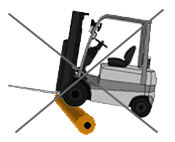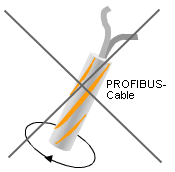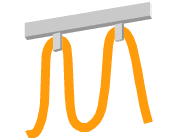| |
1.3.1 Electrical PROFIBUS cables (part tree)
Compression loads
- Do not squash the PROFIBUS cable, e.g. by stepping on it or driving over it.

- In addition, avoid excessive stress or pressure on PROFIBUS cables, e.g. through pinching or squashing
Twisting (torsion)
- Twisting the PROFIBUS cable can cause the individual cable elements to unwind. This, in turn, leads to a deterioration of the electrical characteristics and poor EMC performance. For this reason, do not twist the PROFIBUS cable.

- If twisting cannot be avoided, you must use torsion-proof PROFIBUS cables.
Flexible PROFIBUS cables
- For frequently twisted PROFIBUS cables (for example as used in robots) use flexible, torsion-proof PROFIBUS cables.

Trailing and garland cables
- Use only cables and corresponding suspension components approved by the manufacturer for trailing and garland cables. The correct cables and parts are available from various manufacturers.
- Ensure that trailing and garland cable are not damaged or pinched by structural components or other cables when in motion.
- Ensure that the cables are not crossed between festoon suspensions, since this can cause stretching or stress on the cable. Use separate suspensions for each cable.
- The chosen cable route must avoid any cable twisting. Twisting a PROFIBUS cable can lead to mechanical damage and poor EMC performance.

|
